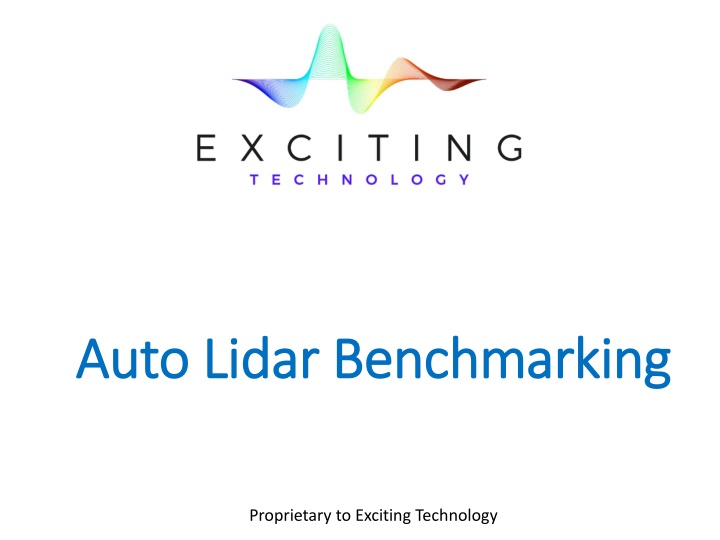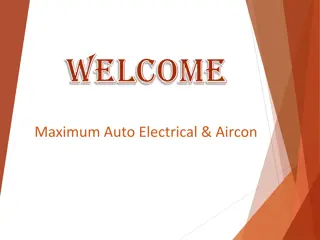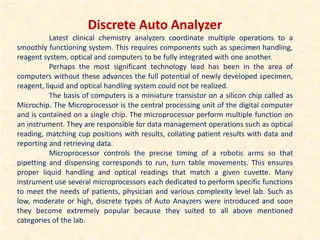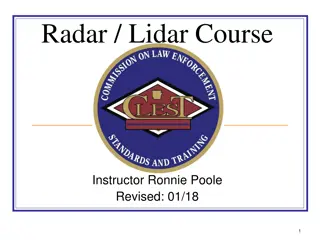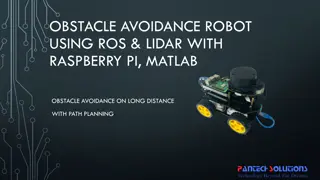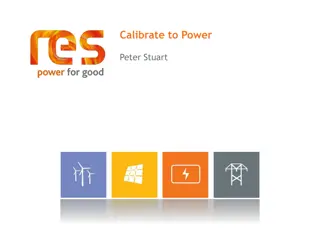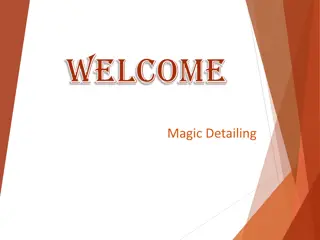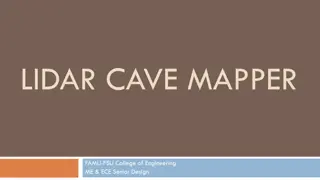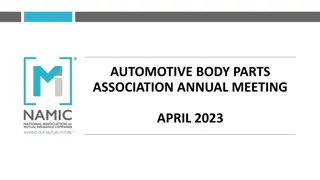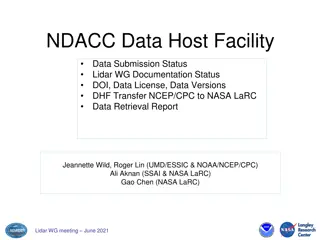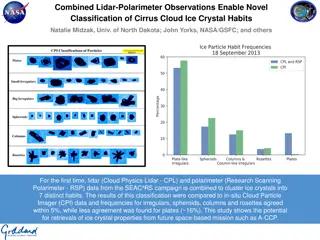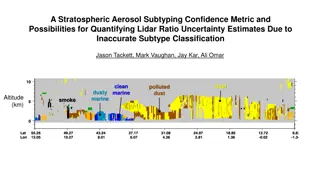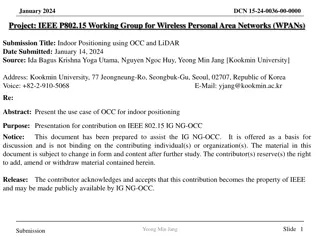Emerging Trends in Auto Lidar Technology
Developing standardized benchmarking tests for auto lidar performance is crucial, especially with the increasing use of lidar in autonomous vehicles. Alongside lidar, other sensors like radar, cameras, and specialized software play vital roles in ensuring safe and efficient autonomous driving. Safety considerations, detection methods, and laser options are key areas of focus in advancing lidar technology for automotive applications.
Download Presentation

Please find below an Image/Link to download the presentation.
The content on the website is provided AS IS for your information and personal use only. It may not be sold, licensed, or shared on other websites without obtaining consent from the author.If you encounter any issues during the download, it is possible that the publisher has removed the file from their server.
You are allowed to download the files provided on this website for personal or commercial use, subject to the condition that they are used lawfully. All files are the property of their respective owners.
The content on the website is provided AS IS for your information and personal use only. It may not be sold, licensed, or shared on other websites without obtaining consent from the author.
E N D
Presentation Transcript
Auto Lidar Benchmarking Auto Lidar Benchmarking Proprietary to Exciting Technology
Auto Lidar benchmarking Auto Lidar benchmarking Goal: Develop standard benchmarking tests for auto lidar performance There are no testing standards now How does an auto company or a tier 1 supplier evaluate auto lidars? Test originally Planned for SPIE Defense and Commercial Sensing (DCS) Symposium in Anaheim. At a baseball stadium parking lot Current plan is to test at DCS in Orlando, 11 - 15 April 2021 May do some preliminary tests, depending on the virus Proprietary to Exciting Technology
Autonomous Vehicles Autonomous Vehicles Lidar will be a critical Sensor, but not the only one Radar, and visible Sensors, and maybe acoustic sensors, will be used 360 LiDAR Rear and Side cameras Front-facing cameras 360 Radar Coverage Custom Software Onboard Computers Accelerometers / Gyroscopes
Eye Safety Considerations Eye Safety Considerations Chart shows relative Eye safety threshold 1 j/cm2 @ 1.5 m, and 1E-6 j/cm2 @ .9 m for nsec to sec pulse width This is for nanosec pulse widths, and a 10 second exposure time. Scanning will increase allowed power, to reach threshold energy in 10 seconds 4
Coherent vs Direct Coherent vs Direct Detection Detection Coherent detection requires an LO, so more complexity Much can be borrowed from radar Coherent Detection can use high duty cycle waveforms, but will need narrow line width lasers High duty cycle makes it easier to use laser diodes Coherent detection can measure velocity Could be an edge sometimes, e.g when someone is stepping off the curb Coherent detection will have speckle issues Have to average out speckle, so likely will have lower sample rate Coherent Lidar has GREAT discrimination against other lidars The case of 6 lanes of traffic each way is made for coherent lidar
Laser Options Laser Options ~905 nm laser diodes are popular Laser diodes are peak power limited, because you cannot Q switch a laser diode Coherent lidars do not need pulsed lasers Most designers will match one laser diode to one detector Laser diodes can be made on wafers, so require very little touch labor At 905 nm they will have a low eye safety threshold (1E-6 j/cm2 ) ~1550 nm Eye safer wavelength (1 j/cm2 ) Usually will use a fiber laser Fiber lasers can cover many detectors. Fiber lasers require more touch labor Most auto lidars will be pulsed, direct detection, but can use coherent LFM, with high duty cycle
Team Team Paul McManamon, Chair: Jeremy Bos, Vice Chair: Michigan Tech Hamzeh Alzubi: Senior controls engineer at FEV North America Joe Buck: Lockheed Martin Senior Fellow Christy Cull: Head of Sensors at Lyft, Level 5 Self-Driving Division; leads AV- sensors at L5 encompassing camera, lidar, and radar. Zack Jeffri: Michigan tech grad student. Charles Kershner: Project scientist at NGA. Dennis Killinger: Has 50 years of lidar experience. Greg McKee: Labsphere chief technologist; Prem Rachakonda: NIST. familiar withmeasurement precision and standards. Dan Sawyer: NIST.familiar withmeasurement precision and standards. Joe Shaw: Professor of electrical and computer engineering, Montana State University Vasanthi Sivaprakasam: NRL lidar employee . Andri Van Rynbach: AFRL lidar researcher. Ed Watson: 35 years of lidar experience. Proprietary to Exciting Technology
Team Team Test Execution Panel: Cullen Bradley: Lead test engineer Eddie Ruff: Assistant test engineer Definition and Analysis panel: Jeremy Bos: Assistant professor of electrical and computer engineering, Michigan Tech. Zack Jeffri: Michigan Tech grad student. Proprietary to Exciting Technology
Initial Test Range Initial Test Range 250 meters long Initially 2 lanes Lane 1 basic tests Lane 2 add confusers Stop signs Large corner cubes to simulate other lidars. 2nd year may add 3rd lane for weather Range finder to measure range to targets Ground truth Lidar Thank you Charlies
Lane 1 Lane 1 Toddler corner case 25 meters out to 250 meters, 10% reflective Toddler case 80 cm tall, by 24 cm wide Elevation and azimuth FOV tests targets spread out) Eye safety
Lane 2 tests Lane 2 tests Many tests from 1st lane Stop signs Large corner cubes to simulate other approaching lidars Close range
Working on processing Working on processing Dr Andre VanRynbach at AFRL in charge of processing Can we do real time automatic capture, and processing, of data? We would like 10 seconds of lidar measurements, at about a 10 hertz frame rate Range and deviation in range from ground truth Position horizontally and deviation in horizontal position from ground truth Position vertically and deviation in vertical position from ground truth
Conference Interaction Conference Interaction Brief results in the exhibit hall Discussion What should be change? Path to a standard Team will publish an article in Optical Engineering
Moving Toward Standards Moving Toward Standards Goal of auto lidar testing standards within 3-4 years Hope to get the Society of Automotive Engineers, SAE, involved after 1st year Revise testing each year
